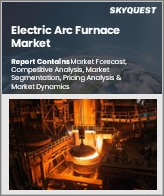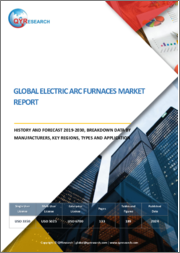
|
시장보고서
상품코드
1616107
퍼니스 커버 시장 성장 기회, 성장 촉진요인, 산업 동향 분석 및 예측(2024-2032년)Furnace Clothing Market Opportunity, Growth Drivers, Industry Trend Analysis, and Forecast 2024 - 2032 |
||||||
2023년 세계 퍼니스 커버 시장 규모는 13억 달러로 평가됐습니다.
예측에 따르면 2024-2032년간 CAGR은 4.7%입니다. 용광로 의류에 대한 수요는 주로 작업자의 안전과 건강에 대한 요구에 의해 주도되고 있습니다. 주조소, 금속 및 철강 생산 현장, 화학 처리 공장 등 온도가 급격히 상승하는 환경에서는 보호복이 필수적입니다. 이러한 보호복은 극한의 열과 용융 금속으로부터 작업자를 보호할 뿐만 아니라 무수한 다른 위험으로부터 작업자를 보호합니다. 용광로 의류 산업은 산업의 성장과 확장의 궤적을 밀접하게 반영합니다.
세계 산업 활동, 특히 신흥 시장의 산업 활동이 급증함에 따라 고온 환경에서 보호복에 대한 수요도 함께 증가하고 있습니다. 이러한 수요를 주도하는 주요 부문으로는 자동차 제조, 항공우주, 발전 등이 있습니다. 또한, 산업 공정이 한계를 넘어서고 종종 전례 없는 고온에 도달함에 따라 혁신적인 용광로 의류 솔루션에 대한 요구가 가장 중요해졌습니다. 산업은 제품 유형, 재료, 유형, 소비자 그룹, 용도, 유통 채널 및 지역으로 나눌 수 있습니다.
자켓 및 코트 부문은 2023년 약 33%의 점유율을 차지할 것으로 예상되며, 2024-2032년까지 연평균 5.4%의 성장률을 보일 것으로 예측됩니다. 용광로 의류의 중요한 구성 요소로 작용하는 재킷과 코트는 가혹한 열, 용융 금속 및 기타 고온의 위협으로부터 작업자를 보호하도록 설계되었습니다. 이 의류는 주로 주조 및 제철소에서 발생하는 강렬한 열로부터 신체의 광범위한 부위, 특히 몸통과 팔을 보호합니다. 금속 및 철강 제조, 자동차, 항공우주, 화학 처리 및 기타 부문의 확장을 목격하면서 고품질 보호복, 특히 재킷과 코트에 대한 수요가 크게 증가하고 있으며, 2023년 내구성 부문의 점유율은 약 82%이며 2032년에는 83%까지 상승할 것으로 예상됩니다. 소비자들은 보호복이 장기적인 투자라는 인식이 확산되고 있습니다.
| 시장 범위 | |
|---|---|
| 시작 연도 | 2023년 |
| 예측 연도 | 2024-2032년 |
| 시작 가격 | 13억 달러 |
| 예상 가격 | 20억 달러 |
| CAGR | 4.7% |
내구성이 뛰어난 소재를 사용하여 여러 계절과 활동에 걸쳐 오래 지속될 수 있는 내구성을 약속하며, 이를 통해 가치를 높입니다. 고급 소재와 건설 기술로 제작된 내구성이 뛰어난 용광로 의류는 단열, 방수, 내마모성 등 성능이 강화된 경우가 많아 가혹한 조건에서 소비자에게 이상적입니다. 북미 용광로 의류 시장은 2023년 약 34%의 점유율을 차지할 것으로 예상되며, 2032년까지 4.9%의 연평균 복합 성장률(CAGR)을 나타낼 것으로 예상됩니다. 북미 기업들은 내열성 의류의 효율성과 수명을 크게 향상시키기 위해 알루미나화 직물 기술 혁신에 앞장서고 있습니다. 알루미나화 직물은 또한 주조소, 제철소, 석유 화학 공장 등 폭염의 위협이 항상 존재하는 산업 환경에서도 주로 사용됩니다.
목차
제1장 조사 방법과 조사 범위
제2장 주요 요약
제3장 산업 인사이트
- 생태계 분석
- 밸류체인에 영향을 미치는 요인
- 이익률 분석
- 변혁
- 향후 전망
- 제조업체
- 유통업체
- 소매업체
- 주요 뉴스와 이니셔티브
- 규제 상황
- 영향요인
- 성장 촉진요인
- 산업의 잠재적 리스크와 과제
- 성장 가능성 분석
- Porter's Five Forces 분석
- PESTEL 분석
제4장 경쟁 구도
- 서론
- 기업 점유율 분석
- 경쟁 포지셔닝 매트릭스
- 전략 전망 매트릭스
제5장 시장 추정·예측 : 제품 유형별, 2021-2032년
- 주요 동향
- Jackets and coats
- Pants and trousers
- Aprons
- Coveralls
- Gloves
- Hoods and helmets
- Boots and shoes
- Face shields
- 기타(Arm Guards, Full Body Suits 등)
제6장 시장 추정·예측 : 재료별, 2021-2032년
- 주요 동향
- 알루미나 섬유
- 피혁
- 내화 코팅면
- 아라미드 섬유
- 포리벤조이미다졸(PBI)
- 기타(울, 울혼방 등)
제7장 시장 추정·예측 : 유형별, 2021-2032년
- 주요 동향
- 내구
- 일회용
제8장 시장 추정·예측 : 소비자 그룹별, 2021-2032년
- 주요 동향
- 남성
- 여성
제9장 시장 추정·예측 : 용도별, 2021-2032년
- 주요 동향
- 주조
- 금속 및 철강 산업
- 자동차 산업
- 항공우주 산업
- 석유 및 가스 산업
- 화학 처리
- 발전
- 노 및 가마 유지보수
- 기타(세라믹, 유리 제조 등)
제10장 시장 추정·예측 : 유통 채널별, 2021-2032년
- 주요 동향
- 직접
- 간접
제11장 시장 추정·예측 : 지역별, 2021-2032년
- 주요 동향
- 북미
- 미국
- 캐나다
- 유럽
- 영국
- 독일
- 프랑스
- 이탈리아
- 스페인
- 기타 유럽
- 아시아태평양
- 중국
- 인도
- 일본
- 한국
- 인도네시아
- 말레이시아
- 기타 아시아태평양
- 라틴아메리카
- 브라질
- 멕시코
- 기타 라틴아메리카
- 중동 및 아프리카
- 남아프리카공화국
- 사우디아라비아
- 아랍에미리트(UAE)
- 기타 중동 및 아프리카
제12장 기업 개요
- 3M
- Ansell
- Bulwark FR
- Carhartt
- Chicago Protective Apparel
- DuPont
- Honeywell Safety Products
- Lakeland Industries, Inc.
- National Safety Apparel
- Oberon Company
- ProGARM
- Stanco Safety Products
- Steel Grip, Inc.
- Tyndale Company, Inc.
- UniFirst Corporation
The Global Furnace Clothing Market was valued at USD 1.3 billion in 2023. Projections indicate a 4.7% CAGR from 2024 to 2032. The demand for furnace clothing is primarily driven by the imperatives of worker safety and health. In environments, such as foundries, metal and steel production sites, and chemical processing plants, where temperatures soar, protective gear becomes indispensable. Such gear not only safeguards workers from extreme heat and molten metal but also from a myriad of other hazards. The furnace clothing industry closely mirrors the trajectory of industrial growth and expansion.
As global industrial activities surge, particularly in emerging markets, the parallel demand for protective clothing in high-temperature environments becomes evident. Key sectors driving this demand include automotive manufacturing, aerospace, and power generation. Moreover, as industrial processes push boundaries, often reaching unprecedented temperatures, the call for innovative furnace clothing solutions becomes paramount. The industry is divided into product type, material, type, consumer group, application, distribution channel, and region.
The jackets and coats segment captured roughly 33% share in 2023 and is projected to grow at a CAGR of 5.4% from 2024 to 2032. Serving as pivotal components of furnace clothing, jackets and coats are designed to protect workers from severe heat, molten metal, and other high-temperature threats. These garments predominantly shield extensive body areas, especially the torso and arms, from the intense heat prevalent in foundries and steel mills. With sectors like metal and steel manufacturing, automotive, aerospace, and chemical processing witnessing expansion, the demand for high-quality protective clothing, particularly jackets and coats, has seen a significant uptick. The durable segment held approximately 82% share in 2023, and projections suggest it will inch up to 83% by 2032. There is a growing perception among consumers that furnace clothing is a long-term investment.
| Market Scope | |
|---|---|
| Start Year | 2023 |
| Forecast Year | 2024-2032 |
| Start Value | $1.3 Billion |
| Forecast Value | $2 Billion |
| CAGR | 4.7% |
By utilizing durable materials, these garments promise longevity across multiple seasons and activities, thereby offering enhanced value. Often crafted with advanced materials and construction techniques, durable furnace clothing boasts performance enhancements like superior insulation, water resistance, and abrasion resistance, making them ideal for consumers in demanding conditions. North America furnace clothing market accounted for about 34% share in 2023, with expectations of a CAGR of 4.9% extending to 2032. North American companies are pioneering innovations in aluminized fabric technology, significantly boosting the efficiency and longevity of heat-resistant clothing. These technological strides, which encompass enhanced heat reflection and added comfort, are driving the market's upward trajectory.Aluminized fabrics are also predominantly utilized in industrial settings, such as foundries, steel mills, and petrochemical plants, where the threat of extreme heat is ever-present.
Table of Contents
Chapter 1 Methodology & Scope
- 1.1 Market scope & definitions
- 1.2 Research design
- 1.2.1 Research approach
- 1.2.2 Data collection methods
- 1.3 Base estimates & calculations
- 1.3.1 Base year calculation
- 1.3.2 Key trends for market estimation
- 1.4 Forecast model
- 1.4.1 Primary research and validation
- 1.4.2 Primary sources
- 1.4.3 Data mining sources
Chapter 2 Executive Summary
- 2.1 Industry 360° synopsis, 2021-2032
Chapter 3 Industry Insights
- 3.1 Industry ecosystem analysis
- 3.1.1 Factors affecting the value chain
- 3.1.2 Profit margin analysis
- 3.1.3 Disruptions
- 3.1.4 Future outlook
- 3.1.5 Manufacturers
- 3.1.6 Distributors
- 3.1.7 Retailers
- 3.2 Key news & initiatives
- 3.3 Regulatory landscape
- 3.4 Impact forces
- 3.4.1 Growth drivers
- 3.4.1.1 Growing awareness about the importance of workplace safety and health
- 3.4.1.2 Technological advancements
- 3.4.2 Industry pitfalls & challenges
- 3.4.2.1 High initial costs
- 3.4.1 Growth drivers
- 3.5 Growth potential analysis
- 3.6 Porter's analysis
- 3.7 PESTEL analysis
Chapter 4 Competitive Landscape, 2023
- 4.1 Introduction
- 4.2 Company market share analysis
- 4.3 Competitive positioning matrix
- 4.4 Strategic outlook matrix
Chapter 5 Market Estimates & Forecast, By Product Type, 2021-2032 (USD Billion) (Million Units)
- 5.1 Key trends
- 5.2 Jackets and coats
- 5.3 Pants and trousers
- 5.4 Aprons
- 5.5 Coveralls
- 5.6 Gloves
- 5.7 Hoods and helmets
- 5.8 Boots and shoes
- 5.9 Face shields
- 5.10 Others (Arm Guards, Full Body Suits, Etc)
Chapter 6 Market Estimates & Forecast, By Material, 2021-2032 (USD Billion) (Million Units)
- 6.1 Key trends
- 6.2 Aluminized fabrics
- 6.3 Leather
- 6.4 Cotton with Fire-Resistant coating
- 6.5 Aramid fibers
- 6.6 Polybenzimidazole (PBI)
- 6.7 Others (Wool and Wool Blends, Etc)
Chapter 7 Market Estimates & Forecast, By Type, 2021-2032 (USD Billion) (Million Units)
- 7.1 Key trends
- 7.2 Durable
- 7.3 Disposable
Chapter 8 Market Estimates & Forecast, By Consumer Group, 2021-2032 (USD Billion) (Million Units)
- 8.1 Key trends
- 8.2 Men
- 8.3 Women
Chapter 9 Market Estimates & Forecast, By Application, 2021-2032 (USD Billion) (Million Units)
- 9.1 Key trends
- 9.2 Foundries
- 9.3 Metal and steel industry
- 9.4 Automotive industry
- 9.5 Aerospace industry
- 9.6 Oil & gas industry
- 9.7 Chemical processing
- 9.8 Power generation
- 9.9 Furnace and kiln maintenance
- 9.10 Others (Ceramics, Glass Manufacturing, Etc)
Chapter 10 Market Estimates & Forecast, By Distribution Channel, 2021-2032 (USD Billion) (Million Units)
- 10.1 Key trends
- 10.2 Direct
- 10.3 Indirect
Chapter 11 Market Estimates & Forecast, By Region, 2021-2032 (USD Billion) (Million Units)
- 11.1 Key trends
- 11.2 North America
- 11.2.1 U.S.
- 11.2.2 Canada
- 11.3 Europe
- 11.3.1 UK
- 11.3.2 Germany
- 11.3.3 France
- 11.3.4 Italy
- 11.3.5 Spain
- 11.3.6 Rest of Europe
- 11.4 Asia Pacific
- 11.4.1 China
- 11.4.2 India
- 11.4.3 Japan
- 11.4.4 South Korea
- 11.4.5 Indonesia
- 11.4.6 Malaysia
- 11.4.7 Rest of Asia Pacific
- 11.5 Latin America
- 11.5.1 Brazil
- 11.5.2 Mexico
- 11.5.3 Rest of Latin America
- 11.6 MEA
- 11.6.1 South Africa
- 11.6.2 Saudi Arabia
- 11.6.3 UAE
- 11.6.4 Rest of MEA
Chapter 12 Company Profiles
- 12.1 3M
- 12.2 Ansell
- 12.3 Bulwark FR
- 12.4 Carhartt
- 12.5 Chicago Protective Apparel
- 12.6 DuPont
- 12.7 Honeywell Safety Products
- 12.8 Lakeland Industries, Inc.
- 12.9 National Safety Apparel
- 12.10 Oberon Company
- 12.11 ProGARM
- 12.12 Stanco Safety Products
- 12.13 Steel Grip, Inc.
- 12.14 Tyndale Company, Inc.
- 12.15 UniFirst Corporation



















